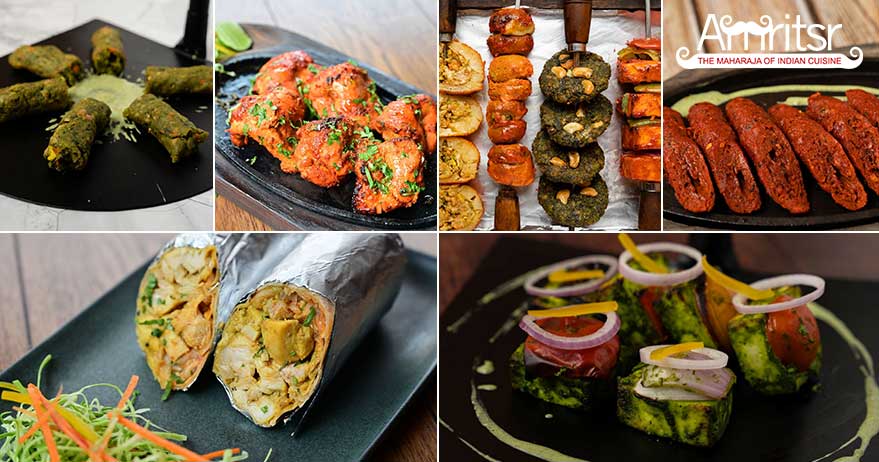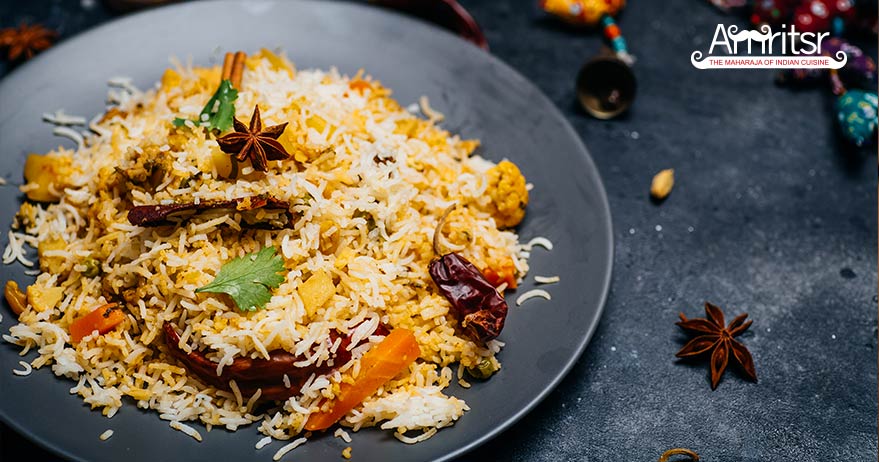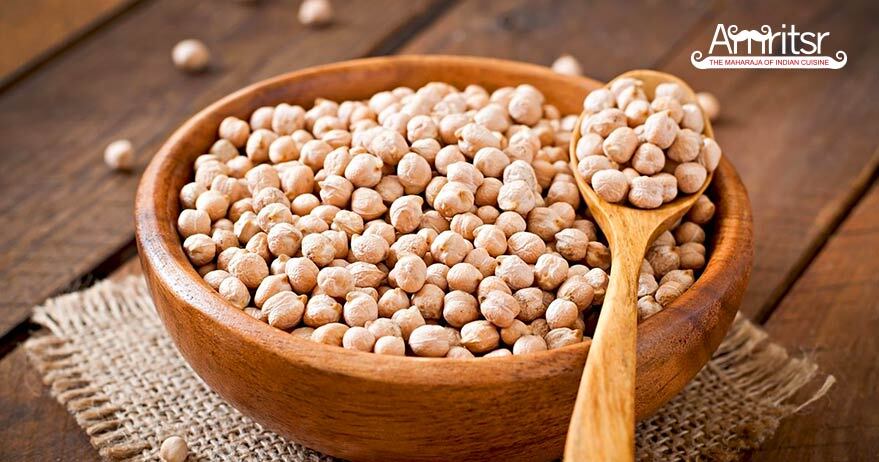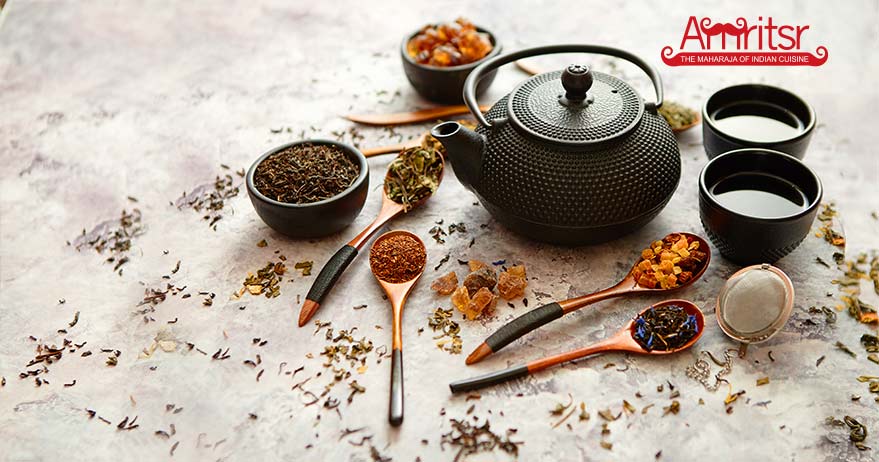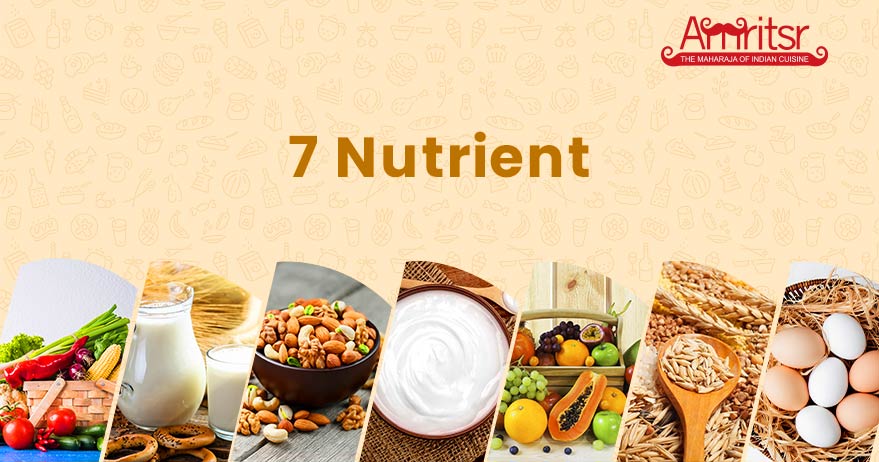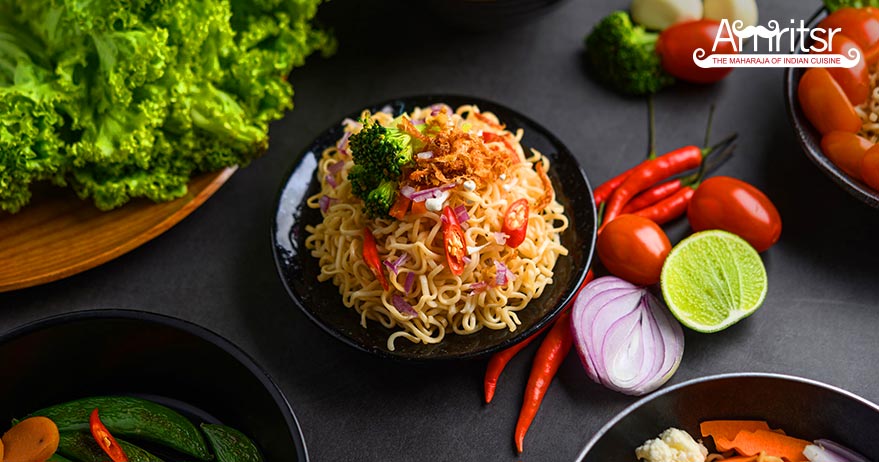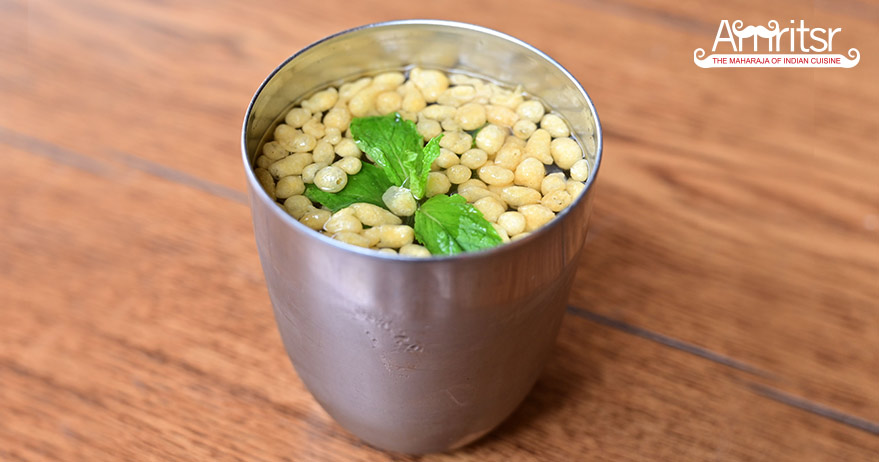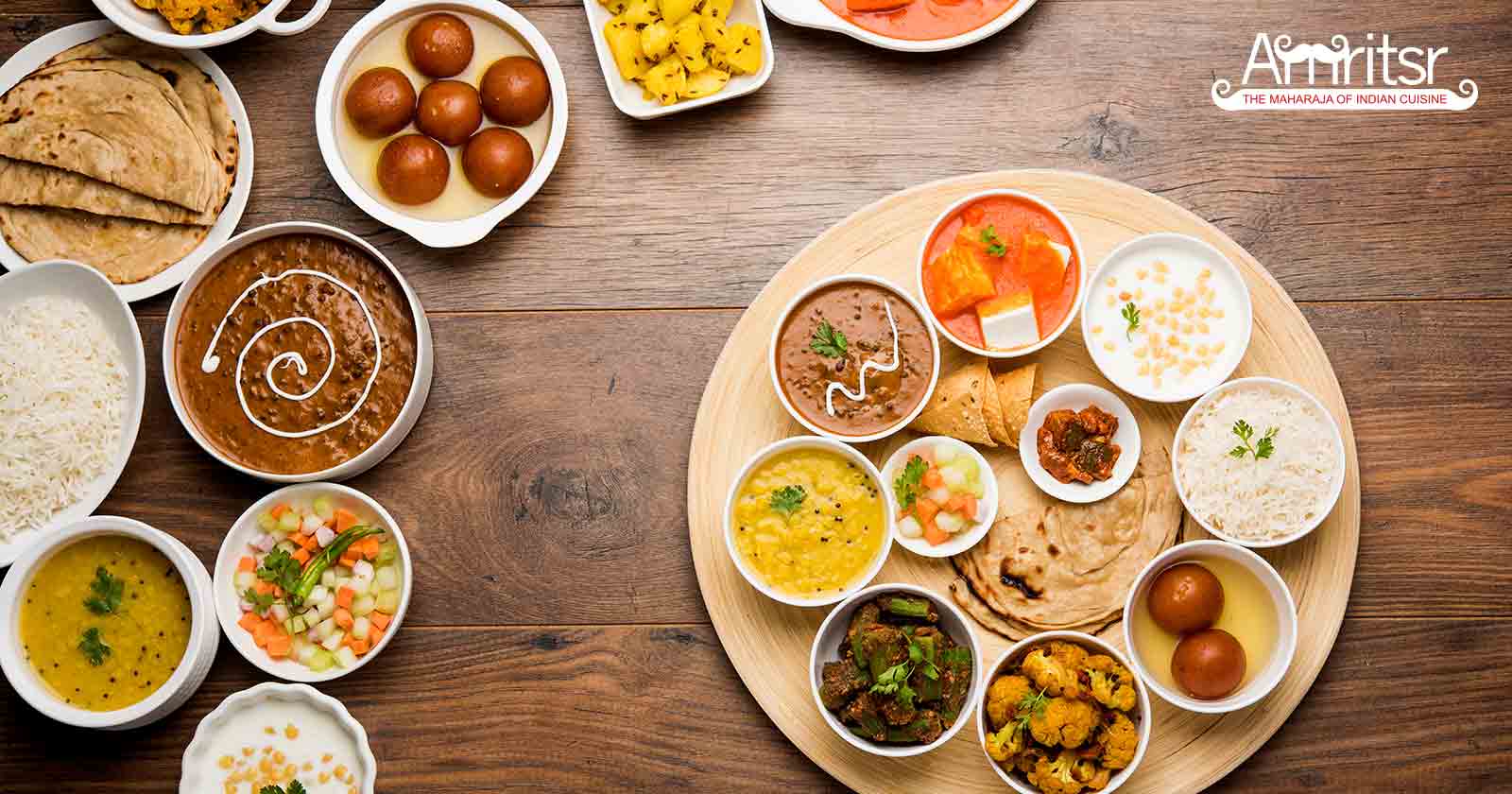What Are Indian Starters? Starters or appetizers are the light dishes usually served at the beginning of the meal or before the main course. Indian starters, as the name suggests, have Indian origin and are packed with Indian spices and flavours. Indian food, in general, is loved by people all around the world. Why Are Indian Starters So Popular? Indian starter\\\’s food is popular for its rich, spicy, and hot flavour. Indian starters unlike others are more wholesome yet not too heavy, leaving the person to crave more. This makes them ideal appetizers. Indian starters also owe their popularity to the variety of authentic Indian restaurants opening around the world that serve real, spicy, and lip-smacking dishes, which many restaurants used to ignore in the past. What Are Some Popular Indian Starters? Many Indian starters find a place in the list of best starters in the world. It would be like cherry-picking when choosing from the vast variety but chicken tikka, hara-bhara kebab, paneer tikka, and chicken tandoori make it to the best Indian starters list. Here Are Some Reasons Why People Love to Eat Indian Starters: Health: Indian starters are made from a variety of spices that are high in antioxidants. Popular Indian starters also include healthy foods like cottage cheese, potato, mutton, chicken, green leafy vegetables, etc. Taste: Indian food is categorized amongst the most delicious foods around the world. Indian cuisine starters are considered lip-smacking and flavourful. Variety: The best Indian starters include both veg Indian starters and non-veg ones. Indian starter\\\’s recipes have diverse flavours and aroma. The options in Indian starters leave a person cherry-picking the best. Amongst the best veg starters list, Indian, paneer tikka, tandoori aloo, etc. are a popular mention. Culture: Starters in Indian restaurants always have the essence of Indian culture and cooking style intact. The distinctive variety of herbs and spices present in the food let Indians feel at home everywhere around the world, while people from other cultures also get to appreciate the unique blend of flavours and an insight into the rich Indian food tradition. List of Starters Available in the Menu of Amritsr, Bangkok: Veg Starters: Paneer Tikka Paneer Hariyali Tikka Paneer Makhmali Kebab Veg Seekh Kebab Hara Bhara Kebab Tandoori Aloo Special Angara Aloo Mushroom Tikka Mushroom Stuffed Tikka Veg Khazana Non-Veg Starters: Chicken Tikka Chicken Achari Tikka Chicken Malai Tikka Chicken Reshmi Kebab Chicken Seekh Kebab Chicken Gilafi Seekh [Kali Mirch] Chicken Tandoori Tangdi Kebab – Stuffed Chicken Keema [2 pieces] Murg Dahi Lehsooni Tikka Murg Kalmi Kabab [3 pieces Kalmi] Non-Veg Khazana Mutton Champ [boneless] Mutton Tikka Tawa [Boneless] Mutton Seekh Kebab Mutton Shami Kabab [6 pieces Tikki] Mutton Gulawti [6 pieces Tikki] Fish Tikka Fish fry Koliwada – Bombay Special Prawns Tandoori Prawns Fry Koliwada – Bombay Special Looking for Something More? Checkout Our Entire Menu. Final Thoughts: Indian starters are the ideal appetizers in any restaurant. Indian cuisine starters are rich in flavour and have a lot of variety. Indian food is popular around the world and we at Amritsr ensure that people in Thailand taste it as well. Amritsr is an Indian restaurant in Bangkok, where one can get authentic Indian starters and food. Indian starters recipe followed by our experienced chefs includes a lot of healthy ingredients, be it cheese, mutton, prawns, and mushrooms, or a large variety of herbs and Indian spices. These ingredients give the dishes a distinctive aroma and taste that compel masses to choose Indian starters over the others. Popular Indian starters include both veg Indian starters and non-veg ones. Indian cuisine represents a culture of unity in diversity, with flavours from different parts of the immensely diverse culture packed in delicious dishes that not only Indians like but masses from all around the globe as well.
10 Foods that Keep you Hydrated
We all know that our body is made up of 75% water. Water is vital for the proper functioning of the body. But drinking water is not the only way to help us stay hydrated. A lot of nutrients rich food we eat also contains high amounts of water. So, one should include water-rich foods, which combines great nutrition with proper hydration, in their diet. Why Are Water-Rich Foods Important? Drinking water alone does not serve the purpose; our body also needs electrolytes with it. Hydrated rich foods have various health benefits and are ideal to fulfill the requirement of nutrients, electrolytes, and water in one plate. Luckily, our favourite popular health food is also considered great hydrating food. Here Is the List of 10 Rich Foods That Keep You Hydrated: 1. Cucumber: The first food to come on our highly hydrating foods list is cucumber. With an impressive 96% water content, it is high in potassium and also great for the skin. 2. Tomatoes: Tomatoes have 95% water in their composition. Tomatoes are rich in lycopene, helping prevent skin cancer and boost the immune system. 3. Mushrooms: These are a good source of protein with low fat and carbohydrate. But these have a surprising 92% water content. Mushrooms are rich in riboflavin, which is great for the heart. It also has antioxidants like selenium. 4. Zucchini: Zucchini is low in carbs and high in dietary fibres, with 95% water content. It is great for weight loss. It can be used as a replacement for pasta and also be used in salads. 5. Watermelon: It is a low calorie, nutrient-rich fruit. It is called watermelon considering its rich water content, i.e. 92%. It contains various vitamins like Vitamin C and lycopene. Also, Know About: 7 Nutrient-Rich Foods You Must Include in Your Daily Diet 6. Strawberries: They have 92% water content. They are low in carbs and sugar with a glycemic index (GI) of 40. They do not lead to a spike in the sugar level either. 7. Broccoli: A popular choice when it comes to healthy vegetables, broccoli with an impressive amount of phytonutrients, antioxidants, and vitamins also has about 91% water content, adding to its already glorious description. 8. Cauliflower: Another popular cruciferous, cauliflower is rich in fibre and flavour with 92% water content. 9. Grapefruits: Grapefruits are low in calories but have a variety of nutrients and about 90% water content. It is also a rich source of vitamin C. 10. Soups: Water being the key element of soups, they are a great option for incorporating various hydrating foods in one bowl. Honorable Mentions: Carrots have 90% water content and are good for vision. Radishes have 95% water content and have a cooling effect on the body. Kiwi, oranges, peaches, and cantaloupes have above 85% water content. Yogurt and milk also have above 85% water content. Celery has about 95% water content. Conclusion: The amount of water required by the body varies from person to person. But hydration with plain water excludes minerals and electrolytes. Water-rich food, thus, serves a vital role by providing the goodness of nutrient-rich food and water. Popular health food is relevant even when talking about hydrated food. Hydrating foods from the highly hydrating foods list like mushrooms and yogurt are a good source of protein. Others are low in calories and carbs and are high in fibres, providing many health benefits and boosting the immune system. Here Are Some Frequently Asked Questions: Q.1. Can we eat dehydrated food daily? No, dehydrated foods are concentrated in sugar and, due to lack of water, are difficult to digest. So, they should only be consumed occasionally. Q.2. What kind of food should we have during winter? Seasonal vegetables and fruits should be consumed. Soups, broths, and other warm foods with fat like ghee (clarified butter) are good in maintaining body temperature and energy. Q.3. What are the health benefits of eating hydrating foods? Hydrating foods help in good digestion, weight management, and low fatigue. Hydrating foods are filling and check to overeat while keeping a person active and hydrated.
Biryani: The Most Lovable and Famous Dish
Biryani is the National dish of India, as everyone loves it unanimously in the country. Not just in India, this evergreen classic dish is even popular in different parts of the world, including Bangkok. The mention of biryani can make you hungry any time – no matter it is morning, noon, or night. For those who cannot live without rice, biryani is a heavenly word. There are various types of biryani, depending on local and hyper-local variations and different cooking styles of people from different regions. The delicious blend of biryani rice and complex flavours of spices gives a unique aroma to this Indian cuisine. If you’ve ever tasted biryani, you know what the hype is all about. After all, there’s no other dish in the world as royal and richly flavoured as biryani. What is Biryani? Biryani is a tasty mixed rice dish that can be enjoyed alone or combined with any Indian curry to enhance its flavour. Biryani is famous throughout the Indian subcontinent and its diaspora. Preparing biryani masala and cooking this semi-cooked rich dish takes practice and time to make. But the effort put in to make this Indian recipe is worth it. When the long-grained rice is flavoured with Indian spices, like saffron, bay leaf, cloves, garam masala, etc. and layered with chicken, lamb, vegetables, or fish dishes with thick gravy, it’s taste is simply mind-blowing, and cannot be compared to any other recipe in the world. Who Invented Biryani? Biryani is known to be invented by Muslims of the Indian subcontinent. However, it came to India very late. Biryani is derived from the Persian word “Birian” which means “fried before cooking” and “Birinj” that’s the Persian word for rice. Although there are so many theories on how this dish was brought to India, it’s often accepted to have originated in West Asia among Muslims of India. Types of Biryani? The following are some famous biryani recipes you must know about: Sindhi Biryani: This aromatic type of biryani is famous in Pakistan. It is known for its fragrance, spicy taste, and delicate meat. Hyderabadi Biryani: It is the most popular biryani in India. It consists of goat meat that’s marinated and further cooked with rice, along with coconut and saffron seasoning. Malabar Biriyani: It is popular in Kerala, an Indian state, and often enjoyed by the Malabar Muslim community with ghee. Calcutta/Kolkata Biryani: This famous biryani is made using eggs and potatoes and, sometimes, includes meat marinated with nutmeg, cinnamon, cloves, cardamom, and other spices. Lucknowi Biryani: It is based on the Persian cooking style and makes use of the dum pukht method wherein the meat and gravy are cooked partially and then layered and served in a handi. Mughlai Biryani: It is typically cooked with chicken, curd, ghee, almond paste, dry fruits, and green chillies for rich flavour. Kalyani Biryani: This biryani contains some chunks of buffalo meat. It is often referred to as \\\”poor man\\\’s Hyderabadi biryani,\\\” as it doesn’t contain any expensive ingredients. Why is Biryani Rice So Popular? Biryani is popular because of: Its rich flavour It is a hearty meal that one can enjoy at any hour of the day or night It is appealing to every palate and age group Some Amazing Facts about Biryani Chicken Biryani is known to be the most ordered dish on online food apps, as per a survey conducted in 2018. Biryani is the most Googled dish all across the world for its recipe. There are over 20 types of biryani recipes, such as Hyderabadi Biryani, Kashmiri Biryani, Lucknawi Biryani, Calcutta Biryani, Malabar Biriyani or Thalassery Biryani, Ambur Biryani, Mughlai Biryani, Sindhi Biryani, Beary Biryani, Bhatkali Biryani, Kozhi Biryani, Assamese Kampuri Biryani, and more. The sub-classification and classification of biryani differ based on the Metallurgy used for cooking. The material of the cooking pot used to prepare biryani makes a great difference in the recipe. Traditionally, biryani is cooked in an earthen pot. But over time people started cooking it in different types of cooking pots. You can enjoy biryani with different combinations of drinks. Most people prefer beer with it; however, North Indians like to have biryani with lassi (buttermilk). List of Biryani that you can taste in Amritsr Restaurant Bangkok Amritsr is the top Indian restaurant in Bangkok where you can find authentic Indian cuisine, including different styles of biryanis. Some lip-smacking biryani recipes to try at Amritsr restaurant are: Veg Biryani Chicken Biryani Mutton Biryani Prawns Biryani Fish Biryani Egg Biryani, etc. You can order biryani or any other Indian meal at Amritsr Restaurant for home delivery at any hour of the day or night. The restaurant also has a food app to make it easier for customers to place orders online.
8 Unexpected Health Benefits of Chickpeas
Chickpea is a legume of the pea or bean family. It has been a popular part of Indian and Middle Eastern diets for ages. There are two basic varieties of the chickpea: The Kabuli and The Desi. The Kabulis are big, white, or beige and have a smoother coat. The desi is darker, smaller, and harder on the outside and is, sometimes, called the Brown Chickpeas or the Black chickpeas. The Health benefits of chickpeas are many, as they are high in fibre, protein, and complex carbohydrates. The calories in cooked chickpeas are low and, at the same time, chickpeas are also essential sources of vitamins and minerals like Vitamin B6, Folate, iron, manganese, selenium, calcium, and potassium among others. High protein and fibre in chickpeas make it popular. Eight Unexpected Health Benefits of or About Chickpeas That You May Not Know: 1. Healthy heart Chickpeas are good for your heart, as they include fibre, potassium, B Vitamins, iron, magnesium and selenium. Chickpeas do not contain cholesterol; rather, the soluble fibre in them helps reduce blood cholesterol. Chickpeas provide around 13 gm of fibre in just one serving (164 gm), which is pretty high. Remember, that fibre-rich diet is linked with a low risk of heart diseases. 2. Helps in weight loss Chickpeas are low calorie and nutrient-rich food. Their fibre and protein-rich composition suppresses appetite and hence, restricts calorie intake. It means that you feel full after having chickpeas and don’t get the urge to unnecessarily eat for the next few hours. This not only helps in weight loss but also maintaining the weight after that. 3. Prevents Cancer Chickpeas reduce the risk of various types of cancers. Butyrate and fibre in chickpeas reduce the risk of colorectal cancer, whereas, vitamin B is known to help protect against breast and lung cancers. Chickpeas also contain saponins, which reduce the risk of multiple types of cancer at the same time. 4. Manage and prevent diabetes Chickpeas don’t increase your sugar levels, as they have a low Glycemic Index (GI). This helps in blood sugar management and also the prevention and management of diabetes. High fibre, Magnesium, B vitamins, and zinc in chickpeas can also help in preventing Type 2 diabetes. 5. Bone and Muscle strength Protein is required for the repair of muscle tissues. Chickpeas, being rich in protein, are beneficial for your muscle strength. Besides protein, chickpeas are a good source of iron, calcium, manganese, and Vitamin K and A, which are essential for bone health. They make your bones stronger and help in preventing Osteoporosis. 6. Digestive benefits Chickpeas, with their high fiber, help in promoting good “gut bacteria” and keep the digestive system smooth and healthy. 7. Healthy brain Choline and selenium in chickpeas enhance various brain functions, including memory, thinking, muscle control and regulation of metabolism. 8. Anaemia Chickpeas are recommended for people with iron deficiency, as chickpeas are a good source of iron and vitamin C (helps in absorption of iron). It can even help overcome fatigue or tiredness among people. Chickpea Nutrition Facts: As mentioned above, chickpeas are nutrient-rich food. Referring to the data of the United States Department of Agriculture, we have listed some of the essential nutrients that one cup of chickpea (164 gm) contains: Energy 267Kcal Carbohydrates 44.7 gm (7.8gm of which is sugar) Protein 14.4 gm Fat 4.2 gm Fibber 12.5 gm Iron 4.7 gm Folate 280 mcg Vitamin K 6.6 mcg Conclusion: Chickpea is a superfood, which has many health benefits. It is a good option for vegetarians and vegans and for those looking to reduce their meat intake. It is gaining popularity globally, and you should also add it to your diet. FAQs: Q: Can we eat chickpeas every day? A: Yes, you can consume it every day. But consult a physician if you are on a medication or allergic to other legumes. Q: How do you eat chickpeas for protein? A: you can consume chickpeas in various ways: Hummus, Falafel, roasted chickpeas, in a vegetable soup, Dal, etc. Q: Are boiled Chickpeas good to eat? A: Yes, but you should boil them properly, as raw or undercooked chickpeas can cause indigestion.
Does Desi Kadha Help Boosting Immunity?
There are several medicinal benefits of desi kadha. Therefore, you must include it in your routine to boost immunity and combat seasonal flu and viral infections. Desi kadha is an Ayurvedic traditional Indian drink known to boost immunity. It includes several herbs and spices that are usually boiled in water for some time, allowing all the effective compounds to be extracted. Kadha is helpful during the cold (or Vata) and dry season when allergies may affect your health. Once boiled with all the ingredients, you must sip desi kadha multiple times in a day. You may even store and reheat before consuming it. If you frequently fall ill or suffer from seasonal flu, your body has low immunity. You must consider desi kadha for immunity booster properties. What is Desi Kadha? Kadha is an ancient Indian drink that includes various herbs and spices to boost one’s immunity. When all the ingredients are boiled in water for a long time, all the medicinal benefits of different ingredients are extracted. The choice of herbs and spices used in desi Kadha for immunity depends on the condition you’re suffering from. Even its taste varies according to the ingredients used for preparation. If you don’t like the taste of kadha, you may even add honey (natural sweetener and immunity booster) to enhance its taste. Why is Desi Kadha famous for Immunity Booster? Kadha is a popular herbal concoction to boost immunity. This is because it contains various spices and herbs, such as cardamom (elaichi), tulsi (basil), kali mirch (black pepper), dalchini (cinnamon), munakka (raisin), shunthi (dry ginger), haldi (turmeric), etc. According to Indian Ayurveda, all these herbs and spices have medicinal benefits to heal the body from within. Therefore, including desi kadha in your diet is a great way to stay healthy and combat infectious diseases. Unlike medicines, these herbs and spices can be added to your favourite dishes as well to enhance their taste while strengthening your immunity. Some Other Benefits of Desi Kadha Besides boosting immunity and fighting infections due to its anti-viral properties, there are various other benefits of desi kadha. This herbal drink is known to improve digestion, as well as detox your body. Consuming kadha is recommended even by some doctors in India, especially during allergy season. Due to the presence of basil in kadha, it is also effective in reducing mucus within the body. Moreover, its antiseptic and anti-inflammatory properties prevent swelling of tonsils while soothing the throat and preventing coughing. Aside from curing flu, fever, cough, etc., you will be amazed to know that kadha also helps in treating stones. It is recommended to consume kadha daily for up to six months to see effective results. Here Are Some Health Benefits of the Ingredients Present in Kadha: Cinnamon: Rich in antioxidants and anti-inflammatory properties. Cardamom: Relieves sore throat and keeps the body cool. Cloves: Improves the immune system of the body. Tulsi (Basil): High in antioxidants. Black peppercorns: Rich in antioxidants and also improves the absorption of turmeric. Here Is the Easy Recipe to Make Desi Kadha Ingredients Required: Elaichi (cardamom) Fresh turmeric Tulsi (basil) Cloves Cinnamon Ginger Black peppercorns Jaggery or honey Munakka Steps to Make Easy Immunity-Boosting Desi Kadha Recipe: Step 1: Firstly, peel the fresh turmeric and ginger. Crush both these ingredients using mortar and pestle. Step 2: Now, take water in a pot and keep it for boiling. Add crushed ginger and turmeric to this water. Step 3: Add the remaining herbs and spices to the water. Step 4: Keep it for boiling for up to 20 to 30 minutes. Step 5: Add jaggery or honey as a sweetener to enhance its taste. Conclusion Desi kadha is known for its benefits in treating cold or flu during the dry season when the allergic reactions are at peak. Made using various Indian herbs and spices, kadha is known to be a natural immunity booster and the best home remedy to cure sore throat and treat flu, cold and cough, and other seasonal infections. It is easy to prepare kadha at home using the given ingredients. If you don’t have all these ingredients with you, you may simply head to Amritsr to enjoy the health benefits of kadha. This Indian Restaurant in Bangkok serves kadha for strengthening the immune system of patrons.
7 Nutrient-Rich Foods You Must Include in Your Daily Diet
The human body cannot produce everything required for its function. Therefore, you need to include the seven essential nutrient-rich foods in your diet to maintain optimal health. Having a balanced diet rich in nutrients is essential for the normal functioning of your body. Therefore, you must consider including nutrient-rich food items in your diet to improve your immune system and overall health. Nutritious foods often include a lot of minerals, vitamins and low-calorie ingredients to nourish your body. They even help in reducing the risk of chronic health conditions. Getting these healthy nutrients through food ensures your body can properly absorb them. So, try eating foods that contain high nutrients. What is Nutrient-Rich Food? Foods that are high in nutrients are often low in sodium, sugar, starch, and bad fats. They even contain high minerals, vitamins, and fewer calories. These help in nourishing the body and keeping you healthy. Such foods also help in reducing the risk of various chronic diseases. Which Nutrient-Rich Foods is Important? Nutritionists spend so much time discussing digestible minerals, vitamins, nutrients, and other fractions of proteins required for the human body. However, people often take important nutrients for granted. To improve your health and immune system, your body requires foods rich in the three macronutrients, such as carbohydrates, proteins, and fats. The body also needs micronutrients (such as vitamins and minerals) in small portions. Food rich in both macro and micro-nutrients is sufficient for a balanced meal. It’s important to consume nutrient-rich foods because they function as the building blocks of your body’s cellular growth, as well as improve immune function, increase energy, and boost overall repair. Following is the List of 7 Nutrient-Rich Food for a Balanced Diet: Vegetables Since vegetables are the main part of the essential nutrients food lists, such as minerals, vitamins, and antioxidants, you must consume a variety of vegetables daily. Vegetables in different colours have a complete range of nutrients for your body. Dark, leafy greens are the best source of essential nutrients. They include: Kale Spinach Broccoli Green beans Collard greens, etc. Yogurt Creamy, thick, and smooth yogurt is a great source of potassium, protein, and calcium. It is also a good source of natural probiotics to improve digestion. The nutrients present in yogurt help build strong bones and keep your immune system stronger. It is best to use plain, non-fat yogurt for making smoothies, dips, and salad dressings. You may even use it for tipping soups, nachos, stews, and other recipe toppings. Nuts Nuts are high in nutrients. So, having a handful of nuts daily is a good way to provide sufficient nutrients to your body. It is best to have almonds, walnuts, cashews, pistachios, etc. in the right portion daily. Eggs Eggs are a great source of natural protein and contain all eight amino acids required for your body. Having eggs daily for breakfast will keep you full for longer and offer you enough energy for working all day long. It even provides sufficient nutrients to your body.
8 Types of Noodles That One Must Try in Bangkok
Noodles (Guay Tiew in Thai) is one of the popular foods in Thailand. However, you must try the best noodles in Bangkok to satisfy your appetite. From veg noodles to chicken schezwan noodles, you can choose from a variety of noodles when you’re in Bangkok. However, if you’re confused with so many options, here are the most popular noodles that you must try in Bangkok. These are too delicious to miss! Here Are 8 Types of Noodles That You Must Try in Bangkok: 1. Vegetable Hakka Noodles Vegetable Hakka noodles, a famous Indi-Chinese dish, is available in many Indian restaurants in Bangkok, as well as some roadside food joints in the city. This dish is very delicious and will make you crave for more. Not just kids, vegetable Hakka noodles are popular among grownups as well. You can enjoy it with any number of veggies of your choice. Generally, mushrooms, carrots, shredded cabbage, capsicum and French beans are added to this dish. 2. Vegetable Schezwan Noodles Vegetable Schezwan Noodles are very spicy and perfect to be enjoyed as it is or with any Chinese-style curry. Just like veg Hakka noodles, you can include vegetables of your choice in this recipe and pair it with spicy schezwan sauce for spicier effect. It is a perfect dish for spice lovers. But if you’re not into spicy food, you might want to avoid this one. 3. Vegetable Garlic Noodles Vegetable garlic noodles are the healthier noodle due to the presence of garlic in it. Since garlic is known to have several health benefits, including curing sore throat, you can enjoy this dish when you’re down with the flu or cold. It is prepared by tossing lightly charred noodles with savoury, gingery and garlicky sauce, along with a touch of nutty sesame oil. The flavours are addictively good! 4. Vegetable Shanghai Noodles Vegetable Shanghai Noodles (Shanghai cu chao mian) are made with thicker and chewier noodles. This dish is easy to make at home using a few ingredients. It just takes 15 to 20 minutes to prepare this dish. If you love vegetarian food, this noodle recipe is a great option for you to prepare at home or enjoy at the best restaurant in Bangkok. 5. Chicken Hakka Noodles Chicken Hakka Noodles includes a zing of soya sauce, chilli sauce, and green chilly. All the ingredients are stir-fried on high flame with delicate chicken pieces and cooked noodles. It is a great meal for any noodle lover – be it a kid or a grownup. Just combine it with savoury Chinese sauces and you cannot stop yourself from having more. 6. Chicken Garlic Noodles Like the taste of chewy garlic noodles? Why not enjoy them with some chicken? It is prepared using thick noodles spaghetti, soaked in water, with a mixture of fresh vegetables and savoury chicken. When served hot, you can enjoy the dish with garlic noodle sauce for an authentic taste. The addition of spicy chilli sauce gives the perfect heat to this meal that is sure to activate all your senses and break a sweat. 7. Chicken Shanghai Noodles This is the stir-fried chicken noodles dish. Using Shanghai-style thick noodles, this dish is prepared just like the vegetable Shanghai noodles. The only difference is that it contains chicken pieces. Generally, chicken Shanghai noodles are served as a side dish. However, you may also enjoy it as a quick dinner in your favourite Indo-Chinese restaurant in Bangkok. 8. Chicken Schezwan Noodles Chicken schezwan noodles are a blast of spices. Besides, chicken schezwan noodles are healthy for you. The crunchiness of vegetables and chicken adds more pleasure to the taste buds. You’d surely enjoy it at home or your favourite Chinese restaurant. Slurping is allowed! Conclusion Are you craving for perfect and healthier noodles in Bangkok? Amritsr is the best restaurant in Bangkok offering various types of noodles for all noodle lovers. They even provide food delivery services. So, if you’re feeling lazy to try any of the mentioned noodle dishes at home, do place your order at Amritsr to enjoy a delicious noodle meal.
Jaljeera: Benefits & Recipe of this Cool & Flavourful Drink
Jaljeera is the wonder drink that many people consume for various purposes. It’s not just a flavourful drink but also known to have many health benefits – from weight loss to maintaining acidity and relieving menstrual cramps. Jaljeera is a nutritious drink for keeping the body cool in summers. This beverage helps with digestion, as it soothes the stomach with its amazing ingredients that are known to treat pain caused due to abdominal cramps. Known to alleviate heartburn, digestion issues and acidity, you can enjoy chilled jaljeera. What is Jaljeera? Jaljeera drink is made from various ingredients, including fresh coriander, rock salt, mint, roasted cumin seeds, black pepper, pepper powder, black salt and dry mango powder. To make it more refreshing, many people put fresh mint and coriander leaves in the jal jeera masala and serve it with ice cubes and lemon slices. Not only a refreshing drink but it is also a great appetizer and a perfect remedy to treat an upset stomach. You may even top your plain jaljeera or jaljeera soda with crispy boondi. What Are the Benefits of Drinking Jaljeera Mentioned below are some amazing jaljeera benefits you need to know: Let\\\’s Know in Detail About Jaljeera Benefits: 1. Supports the Digestion Process Due to the presence of black salt in jaljeera, it helps in combating intestinal gas and helps in the digestion process. It also activates digestive juices and taste buds while relieving heartburn. 2. Treats Nausea Jaljeera powder mixed with water is a great mixture for treating nausea. So, it is a good idea to sip jaljeera whenever you feel like vomiting. 3. Helps in Detoxification Jaljeera contains healthy spices that are effective in detoxifying the body. Besides, it helps reduce body heat and keeps it cool in summers. 4. Helps in Weight Loss Mainly because of the presence of cumin seed powder in Jaljeera, it helps lose weight. Jeera water is known to suppress the appetite and contains fewer calories. Hence, it’s also a great beverage for calorie-conscious people. 5. Treats Menstrual Cramps Jaljeera is known to provide immediate relief to women suffering from menstrual cramps. 6. Best for Acidity Jaljeera is also a great remedy for people suffering from gas or acidity. 7. Rich in Vitamin C Jaljeera contains dry mango powder, which is a rich source of Vitamin C. Vitamin C is essential to improve the immune system. Easy Recipe to Make Refreshing Jaljeera Here is the recipe to make jaljeera at home: Jaljeera main ingredients: Dry Mint Powder – 4 tbsp Citric Acid – 2 tbsp Roasted Cumin Powder – 4 tbsp Ginger Powder – 1 tbsp Black pepper powder – 1/2 tbsp Black Salt – 2 tbsp Hing – 1/4 tbsp Salt – 2 tbsp Sugar – 1 tbsp Dry mango powder – 2 tbsp Easy Step for Jaljeera Recipe: Mix all the given ingredients well and store it in a clean, air-tight container. To make Jaljeera, add 1 tbsp of powder in one glass of chilled water. You may even add ice cubes and lemon juice into the mixture. Serve it chilled. Conclusion Jaljeera is a low-calorie beverage with several health benefits. Whether you want to maintain your weight or get rid of indigestion, jaljeera is a great solution. You can easily prepare it at home. You may even enjoy it at Amritsr Restaurant in Bangkok just before or after your meal. FAQs on Jaljeera Q1: Is Jaljeera good for health? Jaljeera is a naturally refreshing drink that’s good for health. It helps in fighting poor digesting, intestinal gas and rehydrating your body. Jaljeera includes black salt, which is good for digestion. It is a good source of vitamin C and also relieves heartburns. Q2: Can we drink Jaljeera daily? Yes, we can drink jaljeera daily. It is also known as cumin water or jeeragam. This natural drink has various health benefits and is helpful for our body. Q3: When should we drink Jaljeera? Jaljeera is traditionally known as a welcome drink in Indian homes, especially during summers. You may even consume it before meals to build your appetite. If your stomach is upset after a heavy meal, you can have jaljeera after a meal as well. Q4: Does Jaljeera help weight loss? Due to low-calorie count, jaljeera powder aids in weight loss. You can consume it pre or post-workout or whenever you want to quench your thirst or hydrate your body.
What is the Specialty of Indian Cuisine?
While most people around the world think that Indian dishes are all curries. But it’s not true. Many types of Indian cuisine are made either from fish, meat, lentils, or vegetables. The specialty of Indian cuisine is its variety of spices that make each dish exotic, delicious, and stand out from the rest of the cuisines in the world. What is Unique About Indian Cuisine? If you’ve never tried it, you must be wondering what is Indian food like? Well, Indian cuisine has intoxicating aromas, fresh blend of spices and rich ingredients that make it unique and special. The appeal of Indian cuisine is not just limited to Indians; millions of people across the globe love it. But what sets Indian cuisine food apart from other cuisines in the world? Indian food is not just tasty but it’s healthy too due to the presence of some nicest spices that are known for several health benefits. This means Indian food is healthy, aside from being so tasty. A typical Indian dish includes around seven ingredients, along with fresh spices that have their unique flavor. The best thing is that no flavor is suppressed by the other spice and you can enjoy a hint of individual ingredients in every Indian dish. How Many Types of Indian Cuisine? Every region in India has its delicacies and distinct styles of cooking. Since the cooking method varies with changing areas or regions, each dish has something unique about itself. To be precise, about 31 dishes define the Indian cuisines. According to scientists, they have examined more than 2,000 Indian dishes in a common thread. Being the most diverse style of cooking, Indian dishes have become popular across the globe and loved by the masses almost everywhere you travel. What Are the Common Ingredients and Flavours Used in Indian Cuisine? Indian cuisine has most commonly six flavors: sour, sweet, salty, bitter, astringent, and pungent. Indian food is based on the combination of three types of doshas, i.e. Vata, Kapha, and Pitta. These doshas are generated by the elements found in nature, such as earth, fire, water, air, and ether. Indians are known to define their nutrition based on their particular dominant dosha. Another unique thing about Indian dishes is that these ingredients don’t overlap their flavor. Instead, they share equal importance in a dish. If you look at some common Indian ingredients, such as cinnamon, beans, chili peppers, bell peppers, garam masala, chana masala, garlic, cumin seeds, green cardamom, onions, coriander, coconut milk, ginger, cayenne, mustard seeds, and turmeric, you will notice that none of these ingredients resembles each other in terms of flavor. Hence, they all stand alone in each dish. What Are the Three Interesting Facts About India Cuisine? Here are the three interesting facts about Indian cuisine: Land of spices: Indian being the largest producer of spices is rightfully called the “land of spices,” The country alone produces more than 70% of the world’s spices, which is far more than any other country in the world. Historic staple diet: The cuisine in India is known to be made from the same types of grains and ingredients that Indians used to eat thousands of years ago. Today, their staple food consists of whole-wheat flour, rice, and nutritious ingredients. Contains three categories of food: According to Ayurveda, there are three major categories of food in India: Satvic, Tamasic, and Rajasic. Satvic food contains all-natural ingredients, including minimally cooked vegetables, to have a purifying effect on both mind and body. Rajasic food is known to be oily, salty, spicy, or bitter and thus, likely to drive competition, ambition, and egotistic pursuits. Lastly, tamasic food is overly processed and very difficult to digest and hence, known to have harmful effects on the body and mind. Conclusion If you have ever tried any type of Indian cuisine, you would have liked it for its unique taste and flavors. The specialty of Indian cuisine is that it’s healthy, palatable, and easy to prepare at home. However, if you cannot cook it yourself due to work or any other reason, simply call Amritsr Restaurant in Bangkok to order lip-smacking Indian food for yourself and your family.
What are the Healthy Facts About Eating Egg?
The egg is one of the easiest available sources of protein in your kitchen. Besides being a good protein source, there are also other benefits of eating eggs regularly. So, you must include it in your diet in raw or boiled form, as well as make delicious egg recipes at home or order them from your favorite Amritsr restaurant in Bangkok. An egg is known to be a popular source of protein and also rich in many essential nutrients, such as vitamins D, A, B12, and choline. Eggs are inexpensive and can be used to make many interesting recipes for breakfast, brunch, evening snacks, or dinner. Therefore, you can easily make it part of your balanced diet. In this article, we’re sharing some interesting facts about the egg, its health benefits, and also some FAQs related to eating eggs every day. Is it healthy to eat an egg? Undoubtedly, eating eggs every day has multiple health benefits. Not only eggs give your high-quality protein, they even include essential vitamins and minerals, antioxidants, and fatty acids. This means they are valuable for your daily nutrition needs. The egg white is high in protein while the yolk includes some healthy fats, antioxidants, minerals, and essential vitamins. Advantages and Disadvantages of Eating Egg Following are the major advantages of eggs on your health: Rich in nutrients As mentioned before, eggs are rich in essential vitamins and minerals. One single egg fulfils: 25% of your daily folate needs 20% of daily selenium needs 12% of your daily vitamin B2 needs 40% of your daily vitamin D needs It even includes vitamins A, B12, E and B5, along with iodine, phosphorus and iron. High in proteins Proteins are known to be the major building blocks of life. One egg is known to contain around 6.3 grams of protein. The major function of protein is to strengthen, repair and build tissues. It also contains nine essential amino acids in the right proportions for optimum maintenance and growth of your body. Contains good cholesterol and omega 3S Eggs also help in increasing the high-density lipoprotein (HDL) levels and are known to reduce the risk of cardiovascular diseases while improving heart health. It also contains omega-3 polyunsaturated fatty acids that are known to be the essential fats to play a major role in our cell membranes. Disadvantages of eggs Here are some disadvantages of eating eggs: Cholesterol and Saturated Fat According to a dietary guideline for Americans, your cholesterol intake must not be more than 300 mg. A single egg contains 186 mg calories, so if you have two eggs in the morning, you will be over your daily cholesterol level. Diabetes and Eggs According to some health studies, there has been a link between diabetes and dietary cholesterol. A research study in 2013 was published in the American Journal of Clinical Nutrition, stating that there is a connection between Type 2 diabetes risk and egg consumption. What vitamins and minerals are in eggs? If you eat eggs regularly, it boosts your choline intake. Choline is an essential vitamin for improving the function of your brain. Each large egg includes 147 mg of choline, which is around 27% of the suggested daily intake of protein for men or 35% for women, as per the Linus Pauling Institute. Eggs even contain selenium, which is an important mineral to aid thyroid function. Moreover, by eating eggs regularly, your intake of iodine and other vitamins B5, B2 and B12 also increase. Is it OK to eat eggs every day? According to science, you can eat up to three eggs per day for better health and a balanced diet. Eggs improve the amount of HDL (the “good”) cholesterol and there is no increase in LDL (bad) cholesterol for up to 70% of people. Some people may have chances of increasing the LDL benign subtype. So, it’s best to consult your nutritionist before eating eggs. Although it’s easier to prepare eggs at home, if you’re looking for a good restaurant to serve you delicious Indian egg dishes in Bangkok, you must head to Amritsr restaurant. Here are some eggs dishes offered by Amritsr Egg Hakka Noodles It is a palatable Indo-Chinese dish, which everyone in the country loves. It is a healthy dish containing various vegetables that supply a sufficient amount of nutrients to your body. This simple dish can be made easily and quickly. Egg Bhurji Originated from the Indian subcontinent, egg bhurji is a tastier version of scrambled eggs. The only difference is that it contains sauteed chopped chillies, onions and desired spices. It is often served with naan, parantha, pav or rotis. Egg Masala Egg Masala is another tasty egg recipe made using boiled eggs that are simply prepared in spicy masala gravy. This dish has an amazing tangy taste of spices blended with pureed tomatoes. You can prepare this dish using leftover eggs from a party, breakfast or snack time. Egg Curry Egg curry is another delicious egg recipe containing rich onion and tomato gravy. It is simple to prepare and often enjoyed with parantha, naan or rice with some fresh salad. Conclusion Now that you know various health benefits of eggs and amazing recipes that you can prepare at home, do include egg into your daily balanced diet. However, if you ever don’t feel like making egg recipes at home, you can always order them from your favorite Amritsr Restaurant in Bangkok.

